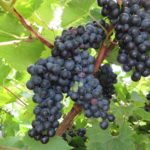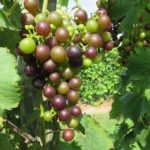Following a very early warm-up, temperatures cooled off the middle of March slowing crop development and bringing us back closer to normal. In southern areas, peaches are in full bloom, but only just showing a little pink in more northern areas. Apples are still in tight cluster and probably at least 10 days from full[Read More…]
Tree Fruit
Grape harvest continues across the state. Overall fruit quality has been excellent, but maintaining that quality with all the rain recently is challenging. Thin skinned varieties have fruit cracking and rot problems. Primocane fruiting blackberry harvest continues into its fourth week on Black magic, with APF-45 just getting started. Heritage and Caroline primocane fruiting raspberries[Read More…]
We just completed a new publication that will assist fruit and vegetable growers in protecting pollinators while still managing their insect pests. The title is “Protecting Pollinators in Fruit and Vegetable Production.” It can be found at https://extension.entm.purdue.edu/publications/POL-2/POL-2.html. There are two companion publications in this series, “Protecting Pollinators in Home Lawns and Landscapes” and “Protecting[Read More…]
Grape harvest has began in the southern part of the state and will begin in central areas over the next week or so. Early varieties are nearing full maturity while late varieties are just at, or not yet at veraison. Overall fruit quality looks excellent. Apple harvest continues. Summer varieties are mostly done and early[Read More…]
Mites continue to be a concern for both fruit and vegetable growers. We are just now at the historical peak population time for European red mites. Fruit growers should be scouting their more susceptible blocks regularly for the next few weeks. The thresholds for treatment increase as we get later in the season. See https://extension.entm.purdue.edu/publications/E-258/E-258.html[Read More…]
Fire blight, caused by the bacterium Erwinia amylovora, is a devastating disease of apples and pears. Epidemics of the disease develop quickly, particularly in a climate of warm, wet weather, with hail events—like last night’s 0.75” to 1.5” hail! The type of management program developed by each orchard will vary considerably based upon a variety[Read More…]
We’re getting close to the time when growers need to make chemical thinning decisions – for many the most perplexing and risky decision they will make all year. This is usually a tricky call to make, even more so when we have had spring frosts. Luckily in most places the spring frosts have not been[Read More…]
Everyone knows that pollinators, including but not limited to honey bees, are important for the production of fruit crops. A big topic in recent years has been the stresses that reduce honey bee populations. Although not most important, pesticides are one factor that can reduce the populations of pollinators. Here are some things fruit growers[Read More…]
The 2016 Midwest Fruit Pest Management Guide (ID-465) is available for purchase from the Purdue Education Store. This publication replaces two previous annual publications: The Midwest Tree Fruit Spray Guide (ID-168) and The Midwest Small Fruit and Grape Spray Guide (ID-169). This guide provides pest management recommendations for commercial tree fruit, small fruit, and grape[Read More…]




